FIAT QUBO 2009 1.G Natural Power Manual
Manufacturer: FIAT, Model Year: 2009, Model line: QUBO, Model: FIAT QUBO 2009 1.GPages: 24, PDF Size: 0.88 MB
Page 1 of 24
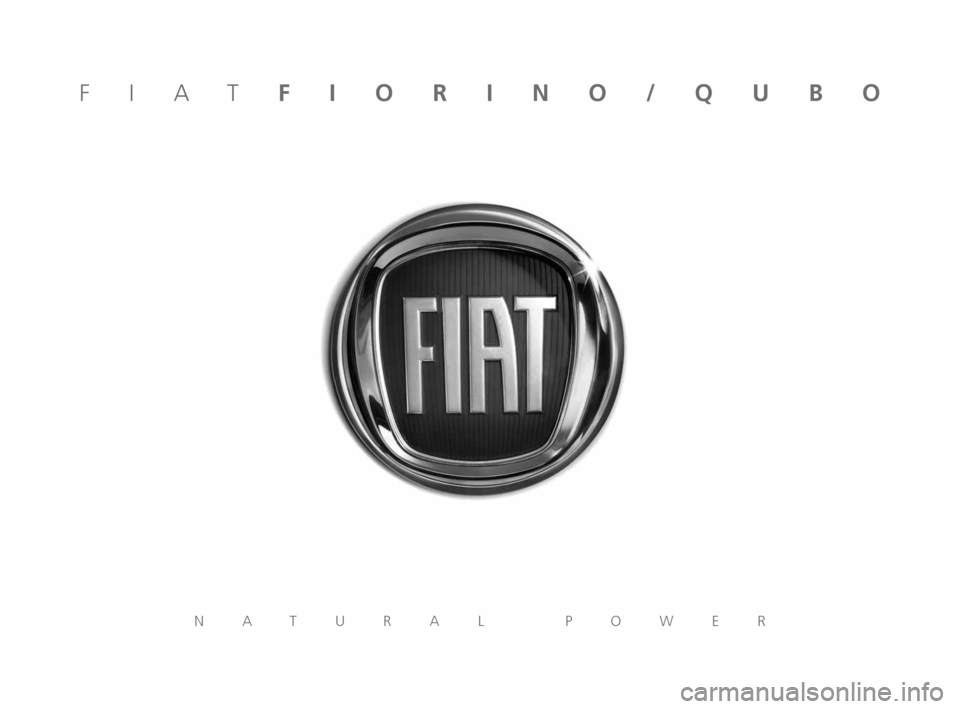
NATURAL POWER
FIATFIORINO/QUBO
603.97.591 FiorinoQubo Nat P 1ed EN 1-12-2009 14:35 Pagina 1
Page 2 of 24
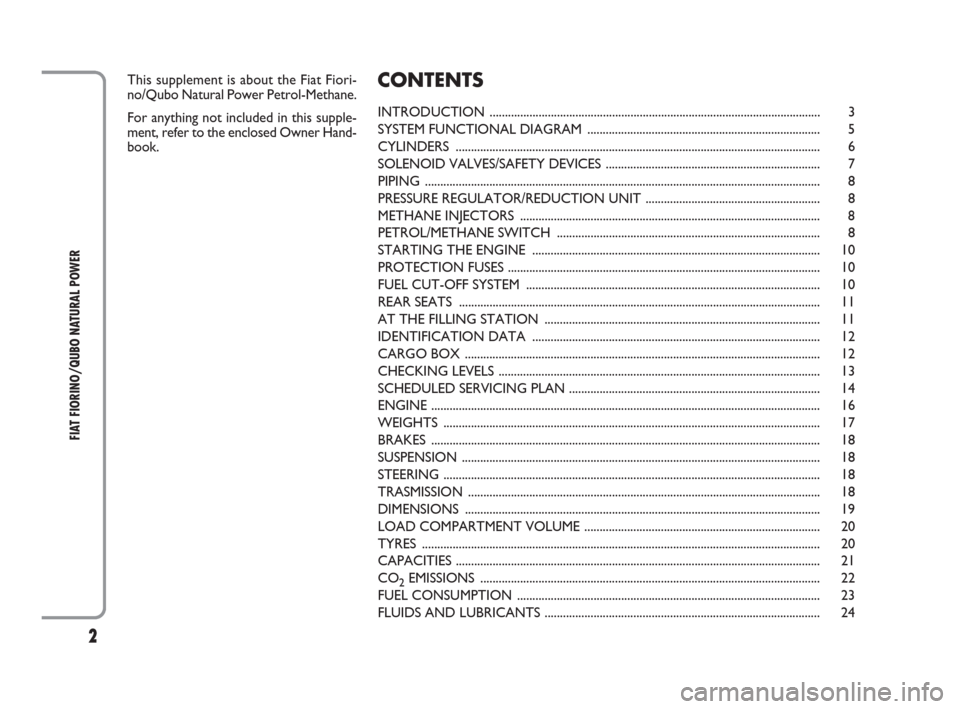
2
FIAT FIORINO/QUBO NATURAL POWER
This supplement is about the Fiat Fiori-
no/Qubo Natural Power Petrol-Methane.
For anything not included in this supple-
ment, refer to the enclosed Owner Hand-
book.CONTENTS
INTRODUCTION ............................................................................................................ 3
SYSTEM FUNCTIONAL DIAGRAM ............................................................................ 5
CYLINDERS ....................................................................................................................... 6
SOLENOID VALVES/SAFETY DEVICES ...................................................................... 7
PIPING ................................................................................................................................. 8
PRESSURE REGULATOR/REDUCTION UNIT ......................................................... 8
METHANE INJECTORS .................................................................................................. 8
PETROL/METHANE SWITCH ...................................................................................... 8
STARTING THE ENGINE .............................................................................................. 10
PROTECTION FUSES ...................................................................................................... 10
FUEL CUT-OFF SYSTEM................................................................................................ 10
REAR SEATS ...................................................................................................................... 11
AT THE FILLING STATION .......................................................................................... 11
IDENTIFICATION DATA .............................................................................................. 12
CARGO BOX .................................................................................................................... 12
CHECKING LEVELS......................................................................................................... 13
SCHEDULED SERVICING PLAN .................................................................................. 14
ENGINE ............................................................................................................................... 16
WEIGHTS ........................................................................................................................... 17
BRAKES ............................................................................................................................... 18
SUSPENSION .....................................................................................................................18
STEERING ........................................................................................................................... 18
TRASMISSION ...................................................................................................................18
DIMENSIONS ....................................................................................................................19
LOAD COMPARTMENT VOLUME ............................................................................. 20
TYRES .................................................................................................................................. 20
CAPACITIES ....................................................................................................................... 21
CO
2EMISSIONS ............................................................................................................... 22
FUEL CONSUMPTION ................................................................................................... 23
FLUIDS AND LUBRICANTS .......................................................................................... 24
603.97.591 FiorinoQubo Nat P 1ed EN 1-12-2009 14:35 Pagina 2
Page 3 of 24
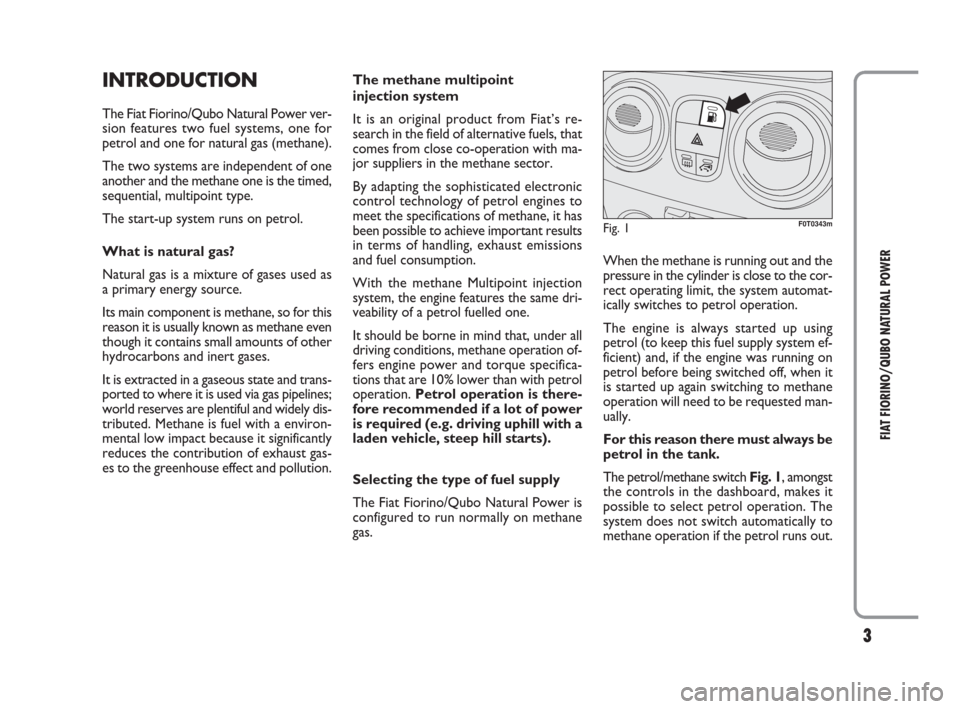
3
FIAT FIORINO/QUBO NATURAL POWER
INTRODUCTION
The Fiat Fiorino/Qubo Natural Power ver-
sion features two fuel systems, one for
petrol and one for natural gas (methane).
The two systems are independent of one
another and the methane one is the timed,
sequential, multipoint type.
The start-up system runs on petrol.
What is natural gas?
Natural gas is a mixture of gases used as
a primary energy source.
Its main component is methane, so for this
reason it is usually known as methane even
though it contains small amounts of other
hydrocarbons and inert gases.
It is extracted in a gaseous state and trans-
ported to where it is used via gas pipelines;
world reserves are plentiful and widely dis-
tributed. Methane is fuel with a environ-
mental low impact because it significantly
reduces the contribution of exhaust gas-
es to the greenhouse effect and pollution.The methane multipoint
injection system
It is an original product from Fiat’s re-
search in the field of alternative fuels, that
comes from close co-operation with ma-
jor suppliers in the methane sector.
By adapting the sophisticated electronic
control technology of petrol engines to
meet the specifications of methane, it has
been possible to achieve important results
in terms of handling, exhaust emissions
and fuel consumption.
With the methane Multipoint injection
system, the engine features the same dri-
veability of a petrol fuelled one.
It should be borne in mind that, under all
driving conditions, methane operation of-
fers engine power and torque specifica-
tions that are 10% lower than with petrol
operation. Petrol operation is there-
fore recommended if a lot of power
is required (e.g. driving uphill with a
laden vehicle, steep hill starts).
Selecting the type of fuel supply
The Fiat Fiorino/Qubo Natural Power is
configured to run normally on methane
gas.When the methane is running out and the
pressure in the cylinder is close to the cor-
rect operating limit, the system automat-
ically switches to petrol operation.
The engine is always started up using
petrol (to keep this fuel supply system ef-
ficient) and, if the engine was running on
petrol before being switched off, when it
is started up again switching to methane
operation will need to be requested man-
ually.
For this reason there must always be
petrol in the tank.
The petrol/methane switch Fig. 1, amongst
the controls in the dashboard, makes it
possible to select petrol operation. The
system does not switch automatically to
methane operation if the petrol runs out.
Fig. 1F0T0343m
603.97.591 FiorinoQubo Nat P 1ed EN 1-12-2009 14:35 Pagina 3
Page 4 of 24
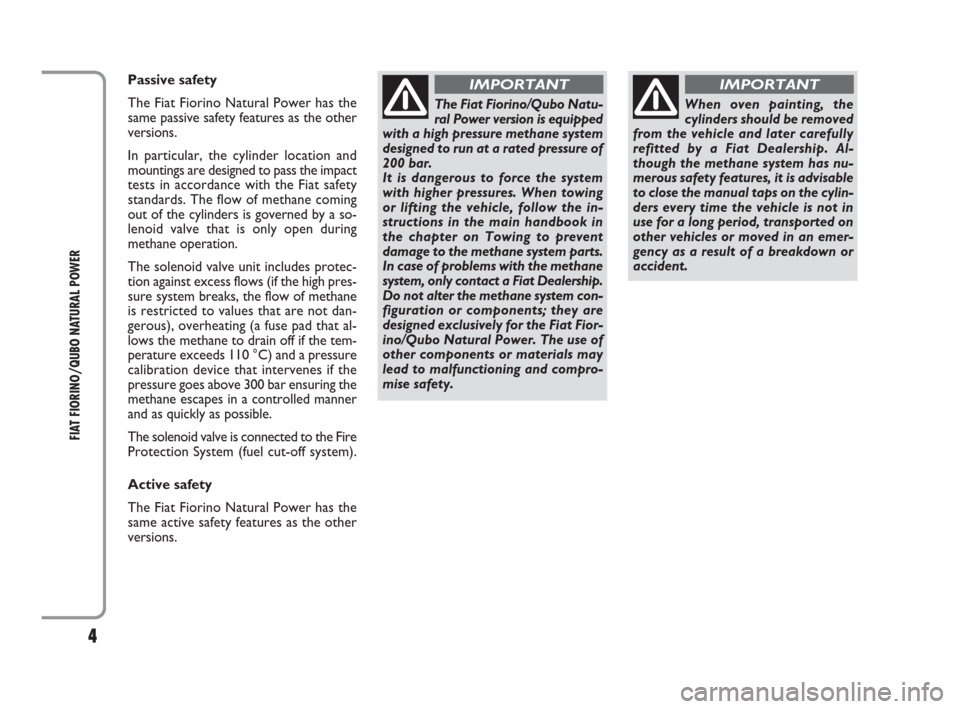
4
FIAT FIORINO/QUBO NATURAL POWER
Passive safety
The Fiat Fiorino Natural Power has the
same passive safety features as the other
versions.
In particular, the cylinder location and
mountings are designed to pass the impact
tests in accordance with the Fiat safety
standards. The flow of methane coming
out of the cylinders is governed by a so-
lenoid valve that is only open during
methane operation.
The solenoid valve unit includes protec-
tion against excess flows (if the high pres-
sure system breaks, the flow of methane
is restricted to values that are not dan-
gerous), overheating (a fuse pad that al-
lows the methane to drain off if the tem-
perature exceeds 110 °C) and a pressure
calibration device that intervenes if the
pressure goes above 300 bar ensuring the
methane escapes in a controlled manner
and as quickly as possible.
The solenoid valve is connected to the Fire
Protection System (fuel cut-off system).
Active safety
The Fiat Fiorino Natural Power has the
same active safety features as the other
versions.
The Fiat Fiorino/Qubo Natu-
ral Power version is equipped
with a high pressure methane system
designed to run at a rated pressure of
200 bar.
It is dangerous to force the system
with higher pressures. When towing
or lifting the vehicle, follow the in-
structions in the main handbook in
the chapter on Towing to prevent
damage to the methane system parts.
In case of problems with the methane
system, only contact a Fiat Dealership.
Do not alter the methane system con-
figuration or components; they are
designed exclusively for the Fiat Fior-
ino/Qubo Natural Power. The use of
other components or materials may
lead to malfunctioning and compro-
mise safety.When oven painting, the
cylinders should be removed
from the vehicle and later carefully
refitted by a Fiat Dealership. Al-
though the methane system has nu-
merous safety features, it is advisable
to close the manual taps on the cylin-
ders every time the vehicle is not in
use for a long period, transported on
other vehicles or moved in an emer-
gency as a result of a breakdown or
accident.
IMPORTANTIMPORTANT
603.97.591 FiorinoQubo Nat P 1ed EN 1-12-2009 14:35 Pagina 4
Page 5 of 24
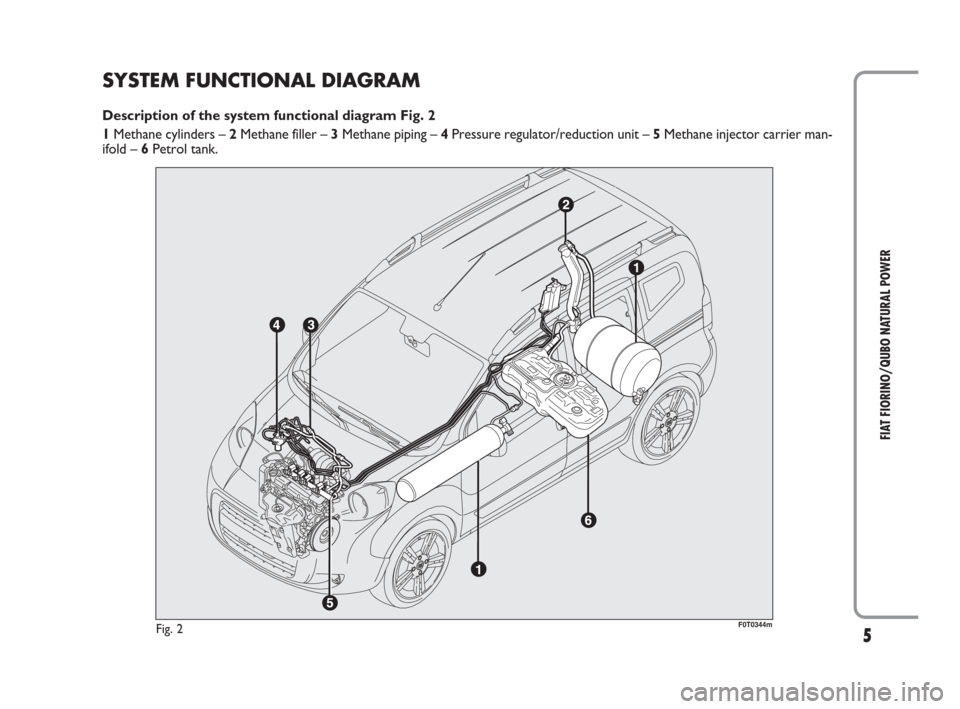
5
FIAT FIORINO/QUBO NATURAL POWER
SYSTEM FUNCTIONAL DIAGRAM
Description of the system functional diagram Fig. 2
1 Methane cylinders –2 Methane filler –3 Methane piping –4 Pressure regulator/reduction unit –5Methane injector carrier man-
ifold –6Petrol tank.
F0T0344mFig. 2
603.97.591 FiorinoQubo Nat P 1ed EN 1-12-2009 14:35 Pagina 5
Page 6 of 24
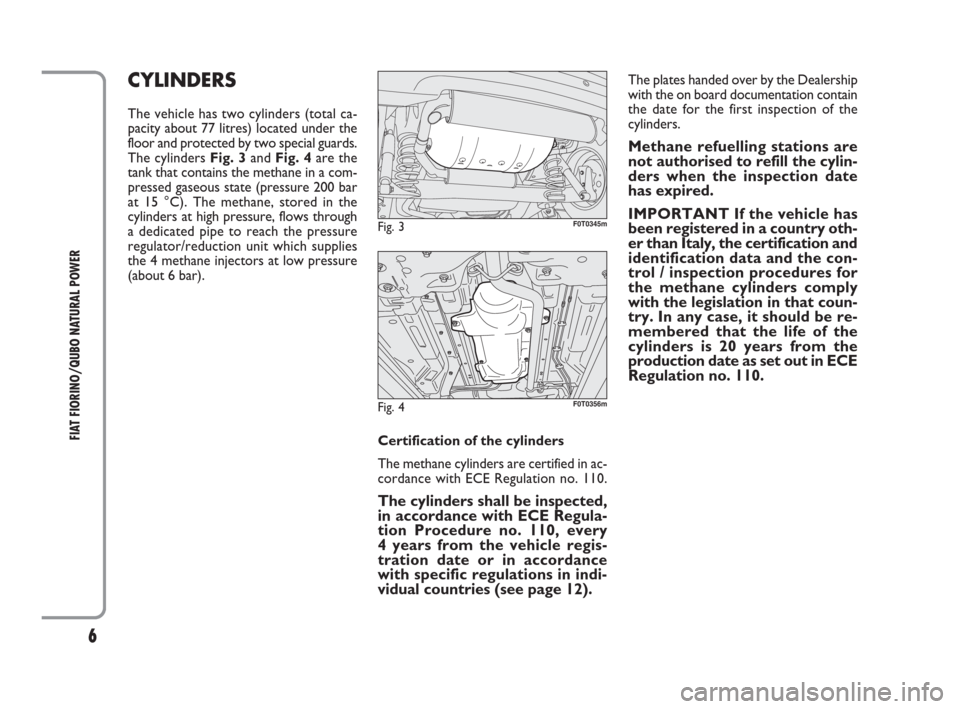
6
FIAT FIORINO/QUBO NATURAL POWER
The plates handed over by the Dealership
with the on board documentation contain
the date for the first inspection of the
cylinders.
Methane refuelling stations are
not authorised to refill the cylin-
ders when the inspection date
has expired.
IMPORTANT If the vehicle has
been registered in a country oth-
er than Italy, the certification and
identification data and the con-
trol / inspection procedures for
the methane cylinders comply
with the legislation in that coun-
try. In any case, it should be re-
membered that the life of the
cylinders is 20 years from the
production date as set out in ECE
Regulation no. 110.
CYLINDERS
The vehicle has two cylinders (total ca-
pacity about 77 litres) located under the
floor and protected by two special guards.
The cylinders Fig. 3and Fig. 4are the
tank that contains the methane in a com-
pressed gaseous state (pressure 200 bar
at 15 °C). The methane, stored in the
cylinders at high pressure, flows through
a dedicated pipe to reach the pressure
regulator/reduction unit which supplies
the 4 methane injectors at low pressure
(about 6 bar).
Fig. 3F0T0345m
Fig. 4F0T0356m
Certification of the cylinders
The methane cylinders are certified in ac-
cordance with ECE Regulation no. 110.
The cylinders shall be inspected,
in accordance with ECE Regula-
tion Procedure no. 110, every
4 years from the vehicle regis-
tration date or in accordance
with specific regulations in indi-
vidual countries (see page 12).
603.97.591 FiorinoQubo Nat P 1ed EN 1-12-2009 14:35 Pagina 6
Page 7 of 24

7
FIAT FIORINO/QUBO NATURAL POWER3) Excess flow,intervenes if the pipes
break and limits the flow of methane ex-
iting to non dangerous levels.
The flow restrictor valve is located to al-
low it to operate even if the solenoid valve
casing is broken due to an impact.
4) Manual tap,it is located upstream of
the solenoid valve.
SOLENOID
VALVES/SAFETY
DEVICES
The solenoid valves Fig. 5and Fig. 6are
bolted directly onto the methane cylinders
with the main function of interrupting the
flow of methane to the supply circuit.
The solenoid valves are open when:
❒the switching button is in the methane
position;
❒the pressure in the cylinder is sufficient
for operation;
❒the engine is running.
The solenoid valve assembly is equipped
with the following safety devices:
1) Fuse pad,in the case of overheating
(temperature above 110 °C), it totally
eliminates the danger of excess pressure
making the methane in the cylinder flow
out as quickly as possible in a controlled
manner.
2) Mechanical excess pressure device
(Burt Disk),in the case of excess pres-
sure (above 330 bar), it ensures that the
methane escapes as quickly as possible in
a controlled manner.It separates the cylinder from the methane
system to allow maintenance operations.
The taps are accessible from outside the
vehicle and are located, in the case of the
lengthwise middle cylinder, at the rear of
the cylinder and, in the case of the trans-
verse rear cylinder, towards the wheel
right side.
To close the taps D-Fig.7: turn the knob
in the direction (1) shown by the arrow
(clockwise
OFF).
To open the taps D-Fig.7: turn the knob
in the direction (2) shown by the arrow
(anticlockwise
ON).
5) Check valve,this prevents the
methane from flowing back to the filler.
Fig. 5F0T0347m
Fig. 6F0T0348m
Fig. 7
1
2
D
F0T0349m
603.97.591 FiorinoQubo Nat P 1ed EN 1-12-2009 14:35 Pagina 7
Page 8 of 24
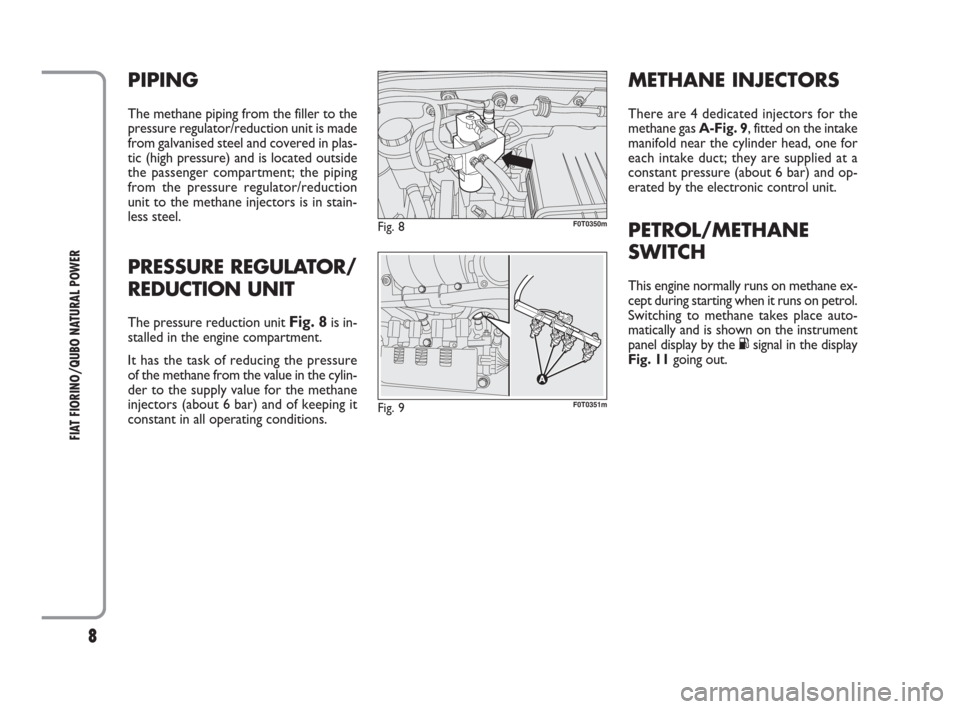
8
FIAT FIORINO/QUBO NATURAL POWER
PIPING
The methane piping from the filler to the
pressure regulator/reduction unit is made
from galvanised steel and covered in plas-
tic (high pressure) and is located outside
the passenger compartment; the piping
from the pressure regulator/reduction
unit to the methane injectors is in stain-
less steel.
PRESSURE REGULATOR/
REDUCTION UNIT
The pressure reduction unit Fig. 8is in-
stalled in the engine compartment.
It has the task of reducing the pressure
of the methane from the value in the cylin-
der to the supply value for the methane
injectors (about 6 bar) and of keeping it
constant in all operating conditions.
METHANE INJECTORS
There are 4 dedicated injectors for the
methane gas A-Fig. 9, fitted on the intake
manifold near the cylinder head, one for
each intake duct; they are supplied at a
constant pressure (about 6 bar) and op-
erated by the electronic control unit.
PETROL/METHANE
SWITCH
This engine normally runs on methane ex-
cept during starting when it runs on petrol.
Switching to methane takes place auto-
matically and is shown on the instrument
panel display by the Ksignal in the display
Fig. 11going out.
Fig. 9F0T0351m
Fig. 8F0T0350m
603.97.591 FiorinoQubo Nat P 1ed EN 1-12-2009 14:35 Pagina 8
Page 9 of 24
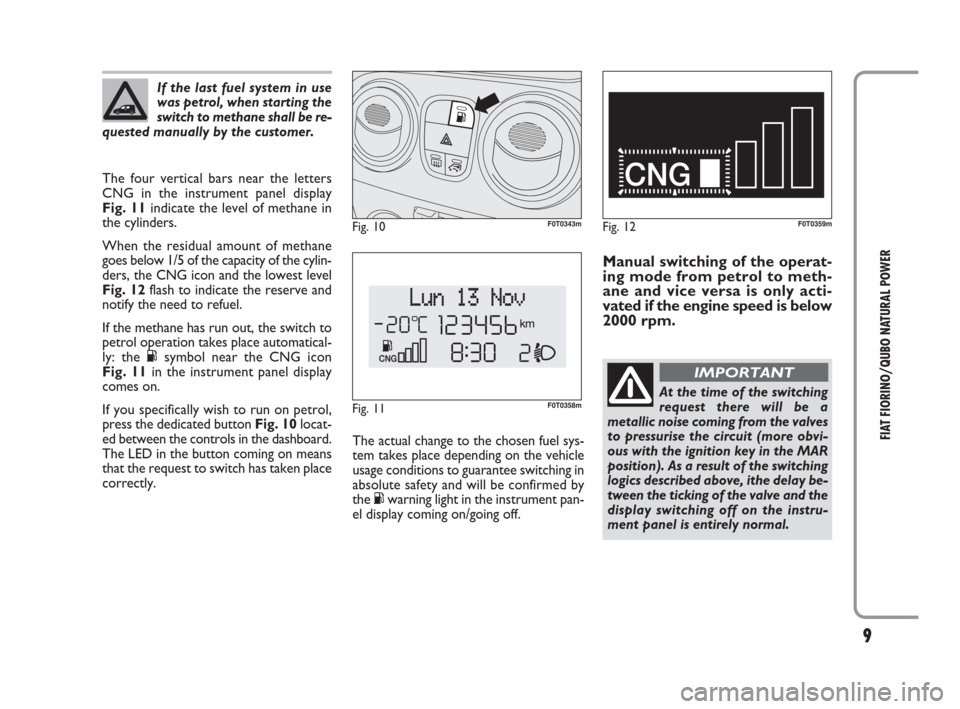
9
FIAT FIORINO/QUBO NATURAL POWER
The four vertical bars near the letters
CNG in the instrument panel display
Fig. 11indicate the level of methane in
the cylinders.
When the residual amount of methane
goes below 1/5 of the capacity of the cylin-
ders, the CNG icon and the lowest level
Fig. 12flash to indicate the reserve and
notify the need to refuel.
If the methane has run out, the switch to
petrol operation takes place automatical-
ly: the Ksymbol near the CNG icon
Fig. 11in the instrument panel display
comes on.
If you specifically wish to run on petrol,
press the dedicated button Fig. 10locat-
ed between the controls in the dashboard.
The LED in the button coming on means
that the request to switch has taken place
correctly.
Fig. 10F0T0343m
Fig. 11F0T0358m
Fig. 12F0T0359m
If the last fuel system in use
was petrol, when starting the
switch to methane shall be re-
quested manually by the customer.
Manual switching of the operat-
ing mode from petrol to meth -
ane and vice versa is only acti-
vated if the engine speed is below
2000 rpm.
At the time of the switching
request there will be a
metallic noise coming from the valves
to pressurise the circuit (more obvi-
ous with the ignition key in the MAR
position). As a result of the switching
logics described above, ithe delay be-
tween the ticking of the valve and the
display switching off on the instru-
ment panel is entirely normal.
IMPORTANT
The actual change to the chosen fuel sys-
tem takes place depending on the vehicle
usage conditions to guarantee switching in
absolute safety and will be confirmed by
the Kwarning light in the instrument pan-
el display coming on/going off.
603.97.591 FiorinoQubo Nat P 1ed EN 1-12-2009 14:35 Pagina 9
Page 10 of 24
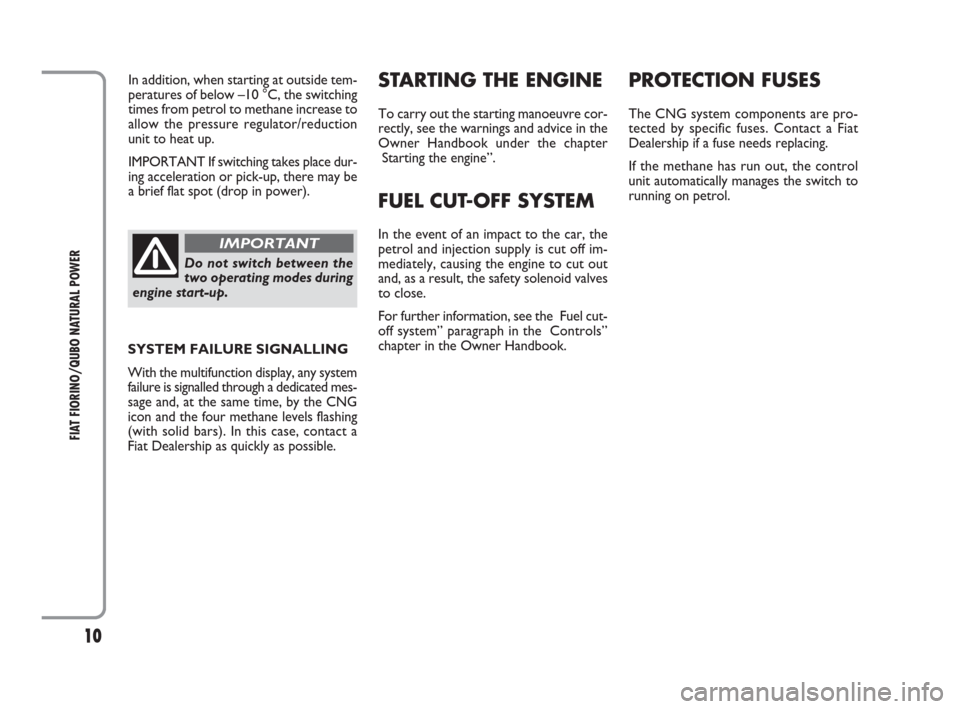
10
FIAT FIORINO/QUBO NATURAL POWER
Do not switch between the
two operating modes during
engine start-up.
IMPORTANT
In addition, when starting at outside tem-
peratures of below –10 °C, the switching
times from petrol to methane increase to
allow the pressure regulator/reduction
unit to heat up.
IMPORTANT If switching takes place dur-
ing acceleration or pick-up, there may be
a brief flat spot (drop in power).STARTING THE ENGINE
To carry out the starting manoeuvre cor-
rectly, see the warnings and advice in the
Owner Handbook under the chapter
Starting the engine”.
FUEL CUT-OFF SYSTEM
In the event of an impact to the car, the
petrol and injection supply is cut off im-
mediately, causing the engine to cut out
and, as a result, the safety solenoid valves
to close.
For further information, see the Fuel cut-
off system” paragraph in the Controls”
chapter in the Owner Handbook.
PROTECTION FUSES
The CNG system components are pro-
tected by specific fuses. Contact a Fiat
Dealership if a fuse needs replacing.
If the methane has run out, the control
unit automatically manages the switch to
running on petrol.
SYSTEM FAILURE SIGNALLING
With the multifunction display, any system
failure is signalled through a dedicated mes-
sage and, at the same time, by the CNG
icon and the four methane levels flashing
(with solid bars). In this case, contact a
Fiat Dealership as quickly as possible.
603.97.591 FiorinoQubo Nat P 1ed EN 1-12-2009 14:35 Pagina 10